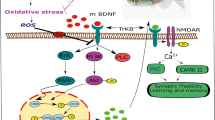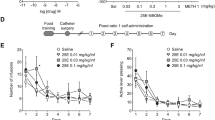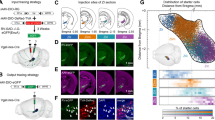Abstract
The ability of 5-HT1 receptor agonists to modulate a chemically induced defence response has been studied in Lister hooded rats. Microinjections of the excitatory amino acidd,l-homocysteic acid (DLH) in both rostral and caudal dorsal periaqueductal gray matter (PAG) caused explosive motor behaviour characteristic of defence. This behaviour was quantified in terms of response duration, arena revolutions and number of defensive jumps. Direct administration into the PAG of either 5-carboxamidotryptamine (5-CT) or 8-hydroxy-2-(di-n-propylamino) tetralin (8-OHDPAT) produced behaviours (decreased exploratory rearing, dose related onset of flat body posture) indicative of 5-HT1A receptor activation. Pretreatment with either 5-CT or 8-OHDPAT directly in the PAG caused a significant attenuation, and in some cases a complete abolition, of the DLH evoked response. These agonists share high affinity in vitro for the 5-HT1A receptor. Thus the results suggest that in vivo activation of 5-HT1A receptors mediates an antiaversive reponse with respect to defensive behaviour elicited by specific chemical stimulation of the dorsal PAG.
Similar content being viewed by others
References
Abrahams VC, Hilton SM, Zbrozyna AW (1960) Active muscle vasodilatation produced by stimulation of the brain stem: its significance in the defence reaction. J Physiol (Lond) 154:491–513
Albin RL, Makiowec RL, Hollingsworth Z, Dure LS, Penney JB, Young AB (1990) Excitatory amino acid binding sites in the periaqueductal gray of the rat. Neurosci Lett 118:112–115
Al Maskati HAA, Zbrozyna AW (1989) Cardiovascular and motor components of the defence reaction elicited by electrical and chemical stimulation in amygdala. J Auton Nerv Syst 15:227–224
Audi EA, Graeff FG (1984) Benzodiazepine receptors in the periaqueductal grey mediate anti-aversive drug action. Eur J Pharmacol 103:279–285
Bandler R, Prineas S, McCulloch T (1985) Further localisation of midbrain neurones mediating the defence reaction in the cat by microinjections of excitatory amino acids. Neurosci Lett 56:311–316
Beckett SRG, Marsden CA, Marshall P (1990) Microinjections of DLH into the rat periaqueductal gray matter induce a dose-dependent defence response attenuated by midazolam. Br J Pharmacol 101:585P
Edwards SB, Flynn JP (1972) Corticospinal control of striking in centrally elicited attack behaviour. Brain Res 41:51–65
Egger MD, Flynn JP (1963) Effects of electrical stimulation of the amygdala on hypothalamically elicited attack behaviour in cats. J Neurophysiol 26:705–720
Engel JA, Hjorth S, Svensson K, Carlsson A, Liljequest S (1984) Anticonflict effect of the putative serotonin receptor agonist 8-hydroxy-2-(di-n-propylamino)-tetralin (8-OH-DPAT). Eur J Pharmacol 105:365–368
Flynn JP (1976) Neural basis of threat and attack. In: Grenell RG, Gabay S (eds) Biological foundations of psychiatry. Raven Press, New York, pp 273–295
Fone KCF, Robinson AJ, Marsden CA (1991) Characterisation of the 5-HT receptor subtypes involved in the motor behaviours produced by intrathecal administration of a variety of 5-HT agonists in rats. Br J Pharmacol 103:1547–1555
Goodchild AK, Dampney RAL, Bandler R (1982) A method for evoking physiological responses by stimulation of cell bodies but not axons of passage, within local regions of the central nervous system. J Neurosci Methods 6:351–363
Hess WR, Brugger M (1943) Das subkorticale Zentrum der affective Abwehrreaktion. Helvetica Physiologica Actal: 33–52 (Translated in: Akert K (ed) Biological order and brain organisation. Selected works of W. R. Hess. Springer, Berlin Heidelberg New York, pp 183–202)
Hoyer D (1988) Functional correlates of serotonin 5-HT1 recognition sites. J Receptor Res 8:59–81
Jenck F, Broekkamp CLE, Van Delft AML (1989a) Effect of serotonin receptor antagonists on PAG stimulation induced aversion: different contributions of 5-HT1, 5-HT2, 5-HT3 receptors. Psychopharmacology 97:489–495
Jenck F, Broekkamp CLE, Van Delft AML (1989b) Opposite control mediated by central 5-HT1A and non 5-HT1A (5-HT1B or 5-HT1C) receptors on periaqueductal grey aversion. Eur J Pharmacol 161:219–221
Jenck F, Broekkamp CLE Van Delft AML (1990) 5-HT1C receptors in the serotonergic control of periaqueductal grey induced aversion. Psychopharmacology 100:372–376
Kennett GA, Witton P, Shah K, Curzon G (1983) Anxiogenic-like effects of mCPP and TFMPP in animal models are opposed by 5-HT1C receptor antagonists. Eur J Pharmacol 164:445–454
Korte SM, Bohus B (1990) The effect of ipsapirone on behavioural and cardiac responses in the shock-probe/defensive burying test in male rats. Eur J Pharmacol 181:307–310
Lawrence AJ, Marsden CA (1990) The effect of systemic 5-carboxamido tryptamine on extracellular levels of 5-HT in the freely moving guinea-pig. Br J Pharmacol 101:519P
Mansbach RS, Geyer MA (1988) Blockade of potentiated startle responding in rats by 5-hydroxytryptamine1A receptor ligands. Eur J Pharmacol 156:375–383
Middlemiss D, Fozard JR (1983) 8-Hydroxy-2-(di-n-propylamino)-tetralin discriminates between subtypes of the 5-HT1A recognition site. Eur J Pharmacol 90:151–153
Paxinos A, Watson C (1982) The rat brain in stereotaxic coordinates. Academic Press, New York
Redfern WS, Hilton SM (1985) Location of brain-stem cell groups controlling the behavioural, respiratory and autonomic components of the defence reaction in the rat. Neurosci Lett Suppl 21:S57
Schutz MTB, De Aguiar JC, Graeff FG (1985) Antiaversive role of serotonin in the dorsal PAG. Psychopharmacology 85:340–345
Soderpalm S, Hjorth S, Engel JA (1989) Effects of 5-HT1A receptor agonists and L-5-HTP in Montgomery's conflict test. Pharmacol Biochem Behav 32:259–265
Tricklebank MD, Forler C, Fozard JR (1984) The involvement of subtypes of 5-HT1 receptor and of catecholaminergic systems in the behavioural response to 8-hydroxy-2-(di-n-propylamino)-tetralin in the rat. Eur J Pharmacol 106:271–282
Author information
Authors and Affiliations
Rights and permissions
About this article
Cite this article
Beckett, S.R.G., Lawrence, A.J., Marsden, C.A. et al. Attenuation of chemically induced defence response by 5-HT1 receptor agonists administered into the periaqueductal gray. Psychopharmacology 108, 110–114 (1992). https://doi.org/10.1007/BF02245294
Received:
Revised:
Issue Date:
DOI: https://doi.org/10.1007/BF02245294




